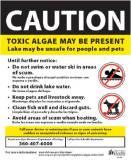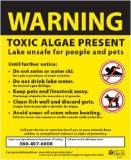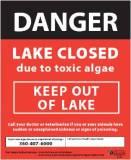Washington State Department of Health has developed guidelines for microcystins and anatoxin-a for those who manage recreational water bodies. The recommended recreational guidance value for microcystins is 6 µg/L and for anatoxin-a it is 1 µg/L. See the complete report, Recreational Guidance for Microcystins and Anatoxin-a (PDF 290KB, 25 pages).
Washington Lakes: Three-tiered Management Approach
The Department of Health developed a framework for managing toxic or potentially toxic cyanobacterial blooms using a three-tiered approach. For more on the framework, see Figure 1 and pages 9 – 12 of the report. The report describes when to take a bloom sample and when local health jurisdictions should post a CAUTION (Tier I), WARNING (Tier II), or DANGER (Tier III) sign.
 |
Tier I. A CAUTION sign is intended to provide the public with information that a public health hazard might exist. It is posted if a bloom is forming or a bloom or scum is visible. | |
 |
Tier II. A WARNING sign is posted if microcystins levels are 6 µg/L or higher and/or anatoxin-a levels are 1 µg/L or higher. The lake should be sampled weekly, at a minimum, with the WARNING sign posted as long as toxin concentrations remain above 6 µg/L (microcystins) or 1 µg/L (anatoxin-a). | |
 |
Tier III. Under certain circumstances, a local health jurisdiction may want to close a lake with unusually high microcystin or anatoxin-a concentrations. A water body can be posted as DANGER – Closed – at the discretion of the local health jurisdiction or appropriate agency. Examples include: very dense blooms covering an entire lake, confirmed pet illnesses or death, and reported human illness. |
More Resources
Search to see which water bodies have toxic algae blooms or report and have blooms tested through the Washington State Toxic Algae Website.
